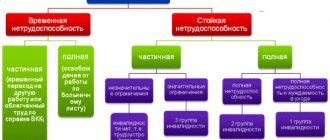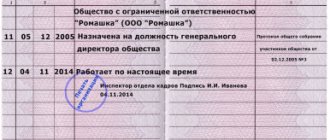General provisions
After signing the agreement, the parties have mutual rights and obligations, which they must strictly observe: the citizen undertakes to work and obey the work schedule in force in the organization, and the employer undertakes to provide the citizen with the work specified in the document and pay wages on time.
Before concluding an employment contract, the employer is obliged to familiarize the future employee with the local regulations of the organization, job description, work schedule, and payment terms. After this, a contract is signed, an order is issued to hire the person and a corresponding entry is made in his work book.
A template, a blank sample employment agreement is contained in Government Decree No. 858 of 08/27/2016.
What should an employer take into account when drawing up an employment contract?
When registering legal relations with an employee, you can insure yourself already at the stage of concluding an employment contract; here are some tips from a labor lawyer:
- Consider initially concluding a fixed-term contract . Very often, the parties think that it is important to stipulate a probationary period in the contract; it will be insurance if the employer encounters incompetent personnel. In practice, it is then very difficult to objectively prove to each other whether the employee passed the test. There are a lot of disputes when the test criteria are not clear to the parties, but you can easily get away from this by immediately signing an agreement for a certain short period; after the end, you will decide to continue working with the employee or look for something else.
- Consider the possibility of tuition reimbursement . If the position requires the employer to invest in improving the employee’s qualifications, then discuss in the conditions at whose expense the expense will be compensated if the employee decides to quit, how long he must work without compensation for training.
- Write down the terms and conditions regarding trade secrets . This way you will insure yourself and your business against leakage of information and ideas of the enterprise that are of interest in a competitive market.
Meaning of the contract
According to Art. 37 of the Constitution of the Russian Federation, each citizen independently chooses his type of activity and specialty. Work is carried out under conditions that do not contradict safety and hygiene requirements. And remuneration must be paid by the employer on time and in full twice a month.
The contract, completed and signed by the parties, is a fundamental legal fact that determines the emergence, change and termination of the official relationship between the employer and employee. It establishes the legal relationship between the worker and the employer and is a set of rules that govern the official relations between the parties who signed the document.
An employment contract is fundamentally different from contracts of a civil law nature (contract, copyright, performance of a certain type of work). Despite their similarities, they differ in the following parameters:
- the subject of the employment contract is the employee’s work. The subject of civil contracts is the final result (book, painting, project);
- an employment agreement presupposes personal performance of work; it cannot be reassigned to another performer. In civil law, this obligation is enshrined in the text of the document;
- under an agreement under the Labor Code of the Russian Federation, the employee is subject to the internal rules of the organization. In civil law there is no such obligation;
- When concluding an employment contract, the employer creates normal and safe working conditions. Under civil law, the employee independently organizes his workplace.
Employment contract for remote hiring
Nowadays, the practice of remote employment is used in many countries of the world, including Russia. Telecommuting has many benefits for both the employee and the employer. Like any other types of labor relations, remote performance of job duties is subject to official registration in accordance with Articles 312.1 and 312.2 of the Labor Code of the Russian Federation.
From the sample employment contract concluded with the condition of remote work, it is clear that it differs from the standard one very slightly:
The main condition for concluding such a document is the employee’s ability to perform his duties and provide results via the Internet or other means of communication, without being at a stationary workplace.
The features of a TD concluded with the condition of remote work are the following:
- The section “Subject of the contract” contains information on the performance of duties in the absence of a stationary workplace controlled by the employer;
- “Place of work” refers to the employee’s address (home or actual). Moreover, if an employee lives in the Far North or other territories with established special payment conditions, he is entitled to all allowances provided for by law;
- The document must state that if it is necessary to visit the head office, the employee receives compensation for travel and travel expenses;
- It is acceptable to include in the text the obligatory use by the employee of software and hardware, equipment, information security systems and other tools or products recommended or provided by the employer in the event of his access to confidential materials;
- The contract includes the most clear conditions for the employee’s availability through specified communication channels on certain days and hours to implement his control, as well as ways to record his presence at a remote workplace;
- The section “Employer Responsibilities”, in addition to the standard points specified by the Labor Code of the Russian Federation, contains the conditions and amounts of compensation payments for expenses on communication tariffs;
- The employee must be warned about the rules for the safe use of the equipment provided to him and the recommended technical means in accordance with paragraphs 17, 20, and 21 of Article 212 of the Labor Code of the Russian Federation;
- At the request of the employer, the work schedule clause may indicate the length of the working week (in hours) and days off.
An employment contract for remote employment is drawn up as follows:
- The form is sent by the employer via electronic communication;
- The employee fills out the form and returns it to the employer;
- Within three days, the employer duplicates the action in “paper” form by mailing a document signed by him. The employee (at his request) sends back the work book and one of the two copies of the TD received by him;
- All documents required for registration are sent by email in the form of scanned files in pdf format or by fax;
In another embodiment, the conclusion of an employment contract is carried out in the usual way during a personal visit by the hired employee to the central office.
Types of employment contracts
There are different types of contracts with employees, depending on the conditions included in it. The employer has the right to develop separate employment contract forms for these cases in order to quickly fill them out.
Most often, an agreement with employees is concluded for an indefinite period of time, that is, it does not specify the validity period of the document. But sometimes it sets a time frame depending on the nature of the work or the conditions under which it is performed. Such cases are considered in Part 1 of Article 59 of the Labor Code of the Russian Federation.
By validity period:
- prisoners for an indefinite period;
- prisoners for a specified period (not more than 5 years).
A fixed-term employment contract becomes indefinite if, after the expiration of the time specified in it, the employee continues to work. In such a situation, the document loses its urgency and is considered concluded for an indefinite period. It is allowed not to draw up a new, unlimited contract.
An open-ended contract can become a fixed-term contract, but this should be justified by the paragraphs of Art. 59 Labor Code of the Russian Federation. To transfer, you must terminate the previous one and enter into a new contract for a certain period.
By the nature of the working relationship:
- by main place of employment;
- part-time (part-time work is impossible without concluding an employment contract, this is the main condition for this type of employment);
- temporary work (if the nature of the work requires it to be completed in less than 2 months, if it is necessary to replace an employee on sick leave);
- short-term contract;
- with seasonal workers;
- with employees working from home;
- on state (municipal) service.
Please note: the Labor Code of the Russian Federation and other legal acts related to labor relations do not apply to certain categories of citizens, provided that they are not employers or their representatives:
- military personnel in the performance of military duties;
- persons working on the basis of civil contracts;
- other persons established by Federal Law (Article 11 of the Labor Code of the Russian Federation).
By type of employer:
- agreements concluded with organizations - legal entities and individual entrepreneurs;
- an employment contract with an individual - when the employer is a citizen without registration as an individual entrepreneur. Most often they hire service personnel.
Depending on the legal status of the employee:
- signed with minor citizens;
- prisoners with persons who have family responsibilities;
- registered with foreigners;
- signed with stateless persons.
By the nature of working conditions, the division is as follows:
- under normal working conditions;
- taking into account occupancy at night;
- concluded with citizens working in the regions of the Far North and in territories equivalent to them;
- in working conditions in hazardous production.
Types depending on the volume of work performed:
- about the main job;
- about part-time work.
In the first case, the employee works full-time for the employer throughout the working day. This is where he keeps his work book.
In the second, a person works in his free time from his main job. The duration of such work is no more than four hours a day. The document signed with the employee indicates that the work performed is part-time. Such a document is allowed to be concluded both at the main place of employment and with another employer. Part-time work is allowed with an unlimited number of employers, except for exceptions established by the legislation of the Russian Federation.
It is not allowed to enter into part-time contracts with persons under 18 years of age and with those whose main work is classified as difficult or performed in hazardous working conditions, if the part-time job implies the same characteristics.
Particular attention is paid to contracts concluded with management employees. When compiling them, there are some features, in comparison with other categories of workers, that should be paid special attention to.
What must be written in it
The list of mandatory information recorded in the employment contract is specified in Article 57 of the Labor Code of the Russian Federation.
Structuring into sections is not mandatory, as is the form itself, but for practical reasons (it’s more convenient), the text following the title “header” is usually divided into the following paragraphs:
- Place and date of document preparation;
- Preamble. The parties between whom the contractual relationship arises are indicated (first the employer represented by the manager or authorized officer, then the surname, name and patronymic of the future employee), followed by the text: “have entered into this agreement on the following.”
- General provisions. This is the main informational part of the contract. It reveals the essence of a previously reached oral agreement, on the basis of which one party undertakes to perform certain duties, and the other pays her for this and provides a package of social guarantees. In particular, the following conditions must be specified: Position and function; Work schedule; If an employee is hired to perform duties in a remote, separate branch - place of work indicating the address; Obligations and rights of the parties; Start date of the contract; The expiration date of the document, if the contract is fixed-term. Without this clause, it is considered indefinite by default; Duration of probationary period. By default, the absence of this clause implies unconditional employment in the position from the very first day.
- Salary. The amount of monthly remuneration, including additional payments and the conditions for their accrual, as well as: Compensations, if they are due under working conditions; Conditions of social insurance; The totality of guarantees provided by the employer; Additional conditions (if any);
- Signatures of the parties. The details of the employer (including TIN) and the details of the hired employee (address, number and series of passport) are indicated.
An agreement containing the above information is drawn up more often than all others, and therefore is called a typical or standard one. In practice, there are other forms of employment agreements.
Points of difficulty
An important part of any contract is its subject, that is, what it is about. Unfortunately, this category is not specified in the Labor Code, and there are no specific explanations in other regulations either. Obviously, the implication is that this is already clear to everyone.
The subject of the employment contract is the employee’s performance of his official duties.
Additional useful information:
- The clause on the employee’s work and rest time is included in the text if the employee has not reached the age of majority or for other reasons cannot work full time;
- The wage clause must indicate the tariff in rubles. The wording “with a salary according to the staffing table” is not legally correct;
- The clause on guarantees and compensation is mandatory if bonuses are due for harmfulness or difficult working conditions;
- The seal of the organization is not a mandatory attribute of the employment contract. If it is placed, it is desirable that the stamp does not make it difficult to read the employer’s details;
- The number of copies of the employment contract in accordance with Article 67 of the Labor Code of the Russian Federation is two, one for each party;
- If the signature from the employer is placed by an authorized person, and not by the manager, the text must contain a link to the document giving such right.
Of course, there is no need to draw up a contract with a hired employee every time. It is enough to create a standard form that meets the requirements of 2021 once and use it. However, the problem with this approach is that different samples can be different and still be correct. The criterion for their suitability is the content of the above mandatory items.
An example of filling out an employment contract with an employee:
Sample
What documents are needed
You should be prepared for any task, including drawing up an employment contract, even if you have a ready-made form. Upon arriving at the HR department, the job applicant must present the following set of documents:
- General passport;
- Employment history;
- Diploma or other qualification certificate, if required;
- Military ID (for citizens liable for military service);
- SNILS;
- Other certification or medical documents, if employment depends on their availability (driver’s license, medical record, access to high voltage, etc.)
It is not necessary to provide a TIN - such a requirement is not specified in the Labor Code, but it will not hurt to take it with you. The absence of a work book for those who are getting the first job in their life should not be embarrassing - it will be kept in the personnel department.
The Labor Code provides for the possibility of concluding contracts with persons who have reached the age of sixteen, and, subject to the consent of parents or guardians, from the age of 14.
Contract form
Organizations and individual entrepreneurs use the standard form of an employment contract with an employee, approved by Decree of the Government of the Russian Federation No. 858 of August 27, 2016.
The agreement is drawn up in writing in two copies. Each copy is signed by the director and employee. One is given to the employee, the second is kept by the employer. To indicate receipt of a copy, the employee puts a personal signature on the document kept by the employer.
If the employee began work with the knowledge of the employer, the contract is considered concluded, even if it was not drawn up in writing.
Example of a completed employment contract:
Where is the completed copy of the agreement stored?
The employment contract form is usually filled out by HR employees, and the employee only has to sign, thereby confirming his familiarity with the sample standard employment contract and agreement with its terms. If the company accepts that the document is filled out by the employee himself, then the HR department will need a sample of filling out the employment contract.
The document is drawn up and signed in two copies (one copy for each party). The completed employment contract form is given to the HR employee, who, in turn, submits it to the head of the organization for signature (if this has not already been done).
After the signing procedure, one copy is kept by the employer, the other is given to the employee. Evasion from signing a contract by the employer or failure to provide a copy to an employee is an offense for which the manager bears responsibility under labor legislation.
This is important to know: Can self-employed people work under an employment contract?
Parties
The parties are the employee and the employer.
An employee is an individual who is 16 years of age or older. The law does not prohibit signing a contract with 14-year-olds. But subject to certain conditions:
- the work is easy;
- does not disrupt the educational process;
- there is the consent of an official representative, most often this is the teenager’s parent.
If a young child is needed, for example, for a role in a movie or theater, then, in addition to the previous conditions, the consent of the guardianship authorities will be required. And also evidence that the work will not cause physical, psychological or moral harm to the child.
An employer is a legal or natural person who is not prohibited from entering into agreements to hire an employee.
Content
According to Article 57 of the Labor Code of the Russian Federation, the document must contain the following information:
- FULL NAME. employee and name of the employing company;
- passport details of the employee (and the employer, if he is an individual);
- employer's tax identification number;
- date and place of signing.
The following information regarding a person’s professional activity is required to be included in the document:
- place of work. Usually this is the organization itself. If the organization has structural divisions, then the place of work is considered to be the division specified in the employment contract;
- position according to the staffing table;
- start date of work (if a fixed-term contract is concluded, its validity period is indicated);
- terms of remuneration (including tariff rate, additional payments, allowances and incentive payments);
- work and rest schedule. If they differ from the general rules established in the organization, then they should be discussed with the job applicant;
- guarantees provided by law and internal regulations;
- nature of the work;
- working conditions in the workplace.
Additionally, they stipulate the rights and obligations of the employee and employer established by the Labor Code and internal regulations of the organization.
In addition, sometimes additional conditions are included:
- about the probationary period;
- on non-disclosure of trade secrets;
- on non-disclosure of secrets protected by law;
- on the types and conditions of additional employee insurance;
- on the employee’s obligation to work for a certain period of time after training, which was carried out at the expense of the employer;
- about financial liability and others.
The completed document is signed by the parties. If changes need to be made to it, the new information is drawn up in the form of an additional agreement.
For non-compliance with the rules for drawing up a contract, the labor inspector, in the case of checking personnel documentation, imposes an administrative fine.
Sample of a simple employment contract with an employee
The employment agreement must include the following:
- Name of the document, date and place of its signing.
- The parties are indicated, which are the employer and the employee entering the job.
- The first section of the agreement sets out the subject matter of this agreement. It indicates where the employee is hired; a fixed-term or open-ended contract is concluded; the day on which the new employee’s work duties will begin. If a probationary period is provided, then its duration is indicated in this part.
- The next section is devoted to what rights and responsibilities are established for an employee from the moment he begins to perform his job duties.
- The following sets out the rights and obligations of the employer.
- The working hours regime is considered and the enterprise’s responsibilities for providing vacations are recorded.
- Issues related to wages are discussed separately. In particular, the salary amount, the procedure for calculating and paying bonuses are recorded here.
- The final portions of this document detail how this document may be modified or terminated.
This is followed by the signatures and data of the parties who signed the employment contract. Usually after this, the employee notes that he has read and familiarized himself with the labor regulations and is ready to comply with them. This document becomes the legal basis of labor relations for the entire duration of the employee’s employment.
Structure
The document consists of several sections, each of which sets out the rights and obligations of the employer and employee. Typically the contract contains the following sections:
- Details of the parties: name of organization, address, full name. manager, full name applicant for the position, his contact details.
- The following usually contains an indication of the position and the division of the enterprise where the applicant will work.
- The following paragraph describes the rights and obligations of the parties. This stipulates the responsibilities of the employee, which he performs in accordance with the job description developed at the enterprise, and the responsibilities of the employer. These include paying wages within a certain time frame, providing subordinates with a safe workplace, equipment, and so on.
- The next section regulates work and rest regimes, specifies the wage rate and internal regulations.
- Sometimes they include a section with additional conditions that do not fall into the main parts of the contract.
- At the end the signatures of the parties and the date are placed.
If, when concluding a contract, some information or listed conditions are not included, this is not a basis for declaring it invalid or a reason for termination. The document is supplemented with missing information. They are included either in the text itself or indicated in a separate agreement between the parties. The additional agreement is also drawn up in two copies and signed by each party.
ConsultantPlus experts discussed how to draw up an extract from an employment contract. Use these instructions for free.
Additional agreements to the employment contract
Any significant changes to the terms of the employment contract oblige the employer to draw up an additional agreement and sign it by both parties. It specifies new operating parameters. A citizen has the right to refuse to sign it.
The employer is prohibited from using coercive measures to conclude an agreement that significantly worsens work activity (for example, transfer to another job, increase in volumes and responsibilities).
If the employee refuses to agree to an agreement, the employer is obliged to leave the terms the same, unless otherwise provided by law. Let's look at examples where the law makes it impossible to apply the previous conditions.
- An employee of the organization was issued a medical certificate, according to which he should be offered another job in accordance with his state of health. The organization is obliged to fulfill the requirements, and if the citizen refuses to sign an additional agreement that his working conditions will change, he must be fired under clause 8 of Part 1 of Art. 77 TK.
- The company has changed its location and invites its employees to sign an agreement indicating the new work address. Refusal will entail termination of the employment contract on the grounds of clause 9, part 1, art. 77 TK.
Additional agreement to the TD when changing the terms of remuneration (salary) - sample
More samples of an additional agreement.
Termination
Termination of a working relationship is permitted at the initiative of the employee (at his own request) and at the initiative of the employer.
Termination at the initiative of the employee occurs when writing a letter of resignation. Usually, in this case, no difficulties arise, unlike the termination of a working relationship at the initiative of the employer. Termination by the employer is permitted before the end of the probationary period with three days' notice in writing. If the probationary period is completed successfully, then termination of the work contract is permissible only in the following cases:
- liquidation of the enterprise;
- staff reduction;
- repeated failure by an employee to fulfill his duties, repeated appearance at the workplace in a state of alcohol, drugs or other intoxication;
- committing theft, embezzlement, intentional causing of material damage;
- other cases specified in Art. 81 Labor Code of the Russian Federation.






